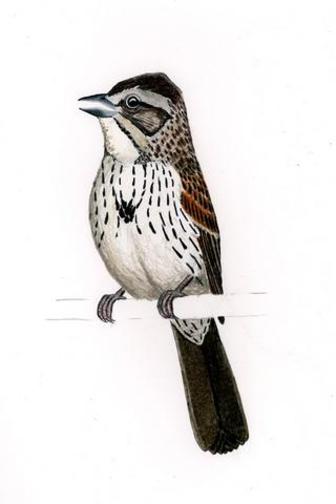Sierra Madre Sparrow
It is the sole species in the genus Xenospiza; the genus is closely related to Ammodramus , differing mainly in the longer, less pointed tail, and restriction to high altitude alpine grassland habitats.

Original source: Transferred from en.wikipedia; Transfer was stated to be made by User:PurpleHz.
Author: Original uploader was Natureguy1980 at en.wikipediaPermission(Reusing this file)This file is licensed under the Creative Commons Attribution 2.5 Generic license.You are free:to share – to copy, distribute and transmit the work
Permission: GNU Free Documentation License
The Sierra Madre Sparrow is classified as Endangered (EN), considered to be facing a very high risk of extinction in the wild.
The Sierra Madre Sparrow (Xenospiza baileyi) is an endangered, range-restricted, enigmatic American sparrow endemic to some mountain ranges in and near the Sierra Madre Occidental, Mexico. It is threatened with extinction due to habitat loss. It is the sole species in the genus Xenospiza; the genus is closely related to Ammodramus (and included in it by some authors), differing mainly in the longer, less pointed tail, and restriction to high altitude alpine grassland habitats. More
* A male Sierra Madre Sparrow which showed up for a short time. Bajío de Aguinaldos, Durango State, Mexico (Northern) monicayhector 18 weeks ago 3 Sounds 2 recordings * A song. La Cima, Mexico DF State, Mexico (Northern) monicayhector 2 August 2001 17 weeks ago 4 * An adult calling twice. More
Durango, that the Sierra Madre Sparrow was recognized as a valid and distinct species. Its life history and population status were poorly understood until Adán Oliveras de Ita, Octavio R. Rojas-Soto, and Héctor Gómez de Silva conducted important recent research, first finding the bird in the state of Durango (where it hadn’t been seen since 1951), and then studying its territoriality and survivorship. More
The Sierra Madre Sparrow makes its home in medium to tall bunch-grass meadows at elevations of 7,500–10,000 feet. This habitat is threatened in several ways. Large swaths are burned to promote new growth for grazing. Some has been converted to oat fields, and the native bunch-grass is harvested for thatch and brushes. Urban encroachment is increasing. More
the vicinity have Striped and Sierra Madre sparrows; the latter has been seen by few people and is one of the few birds in North America for which a photograph had never been published until a few years ago (it first appeared in Eagle-Eye Tours’ brochure and web site). In this season, the tropical dry forest that we visit is humming with hummingbirds, and we should see among others Golden-crowned Emerald, Dusky and Violet-crowned Hummingbirds. Golden Vireo and Rusty-crowned Ground-Sparrows are also more easily seen that at any other season. More

Original source: Original uploader was Natureguy1980 at en.wikipedia
 Passeriformes
PasseriformesFamily : Emberizidae
Genus : Xenospiza
Species : baileyi
Authority : Bangs, 1931

